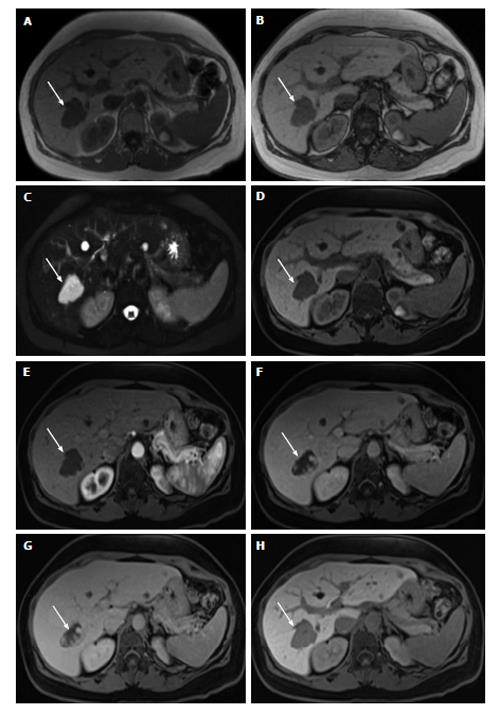Copyright
©The Author(s) 2015.
World J Hepatol. Aug 8, 2015; 7(16): 1987-2008
Published online Aug 8, 2015. doi: 10.4254/wjh.v7.i16.1987
Published online Aug 8, 2015. doi: 10.4254/wjh.v7.i16.1987
Figure 1 Hemangioma.
In (A) and opposed-phase (B) GRE T1-WI, fat-suppressed FSE T2-WI (C), pre (D) and post hepatocyte-specific contrast agent (Eovist®) fat-suppressed 3D-GRE T1-WI at the arterial (E), portal venous (F), interstitial (G) and hepatobiliary (H) phases. There is a lobulated lesion on the right hepatic lobe (arrows), showing marked low signal intensity on T1-WI (A, B and D) and marked high signal intensity on T2-WI (C). The lesion demonstrates peripheral and discontinuous nodular enhancement (E), which become larger and coalescent on delayed postcontrast images (F and G), showing a progressive centripetal filling. Due to the absence of hepatocytes, hemangiomas show low signal intensity on the hepatobiliary phase (H), acquired 20 min after the administration of the hepatocyte-specific contrast agent. GRE: Gradient-echo; FSE: Fast spinecho; T1-WI: T1-weighted images.
- Citation: Matos AP, Velloni F, Ramalho M, AlObaidy M, Rajapaksha A, Semelka RC. Focal liver lesions: Practical magnetic resonance imaging approach. World J Hepatol 2015; 7(16): 1987-2008
- URL: https://www.wjgnet.com/1948-5182/full/v7/i16/1987.htm
- DOI: https://dx.doi.org/10.4254/wjh.v7.i16.1987









